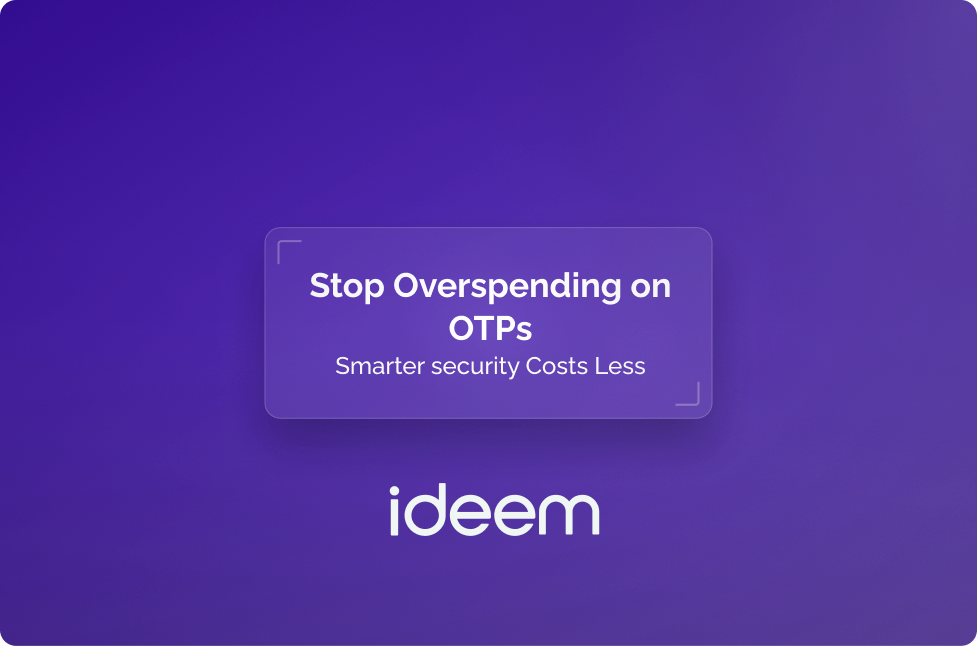Stop Overspending on OTPs. Smarter Security Costs Less.

TLDR
OTPs are costing businesses far more than they realize. While each code costs only a few cents, the bill multiplies quickly across millions of transactions. Add in fraud losses, user drop-off, and support overhead, and OTPs become one of the most expensive forms of authentication. A Zero-Trust Secure Module (ZSM) cuts authentication costs in half on average while providing stronger, phishing-resistant protection. Replacing OTPs with ZSM means less spend, less fraud, and better user experience—all at the same time.
OTPs: A Familiar But Expensive Habit
One-time passcodes (OTPs) have been the go-to method for two-factor authentication for years. They are familiar, easy to deploy, and often seen as “good enough.” But behind the scenes, OTPs are quietly draining budgets. Every text message or push notification has a cost attached, and when multiplied across millions of users, those costs quickly add up.
The problem is not just the price tag of sending codes. OTPs create inefficiencies across the business, from higher support calls to abandoned transactions, that eat away at margins. What looks like a small per-message fee becomes a significant recurring expense.
The True Cost of OTPs
When evaluating OTPs, most organizations focus only on the delivery cost. On average, each code costs a few cents. Scale that to millions of transactions per month and the numbers turn into hundreds of thousands of dollars annually.
But the financial burden does not stop there:
- Fraud losses: OTPs are highly phishable, making them a prime target for attackers. Fraud costs dwarf delivery fees.
- User drop-off: Every extra step in a login or checkout flow increases abandonment rates. Lost revenue from abandoned sessions is often invisible but very real.
- Operational drag: Support teams spend time helping customers who never received or could not enter their OTP correctly. That is labor cost you do not get back.
When you look at the complete picture, OTPs are one of the most expensive ways to secure user accounts.
A Smarter Approach to Authentication
Modern authentication does not have to be a drain on resources. Device-bound methods like a Zero-Trust Secure Module (ZSM) remove OTP delivery costs entirely while providing stronger protection against phishing and fraud.
On average, organizations adopting ZSM see authentication costs cut in half. And that is before factoring in the reduction of fraud-related losses and improved conversion rates. By eliminating the recurring expense of OTP delivery, companies can reallocate budget to growth initiatives instead of maintaining an outdated security method.
Why Cutting Costs Does Not Mean Cutting Corners
Security and savings do not often go hand in hand, but in this case, they do. ZSM is not just less expensive, it is more effective. By binding authentication to the user’s device and applying zero-trust principles, it closes the vulnerabilities OTPs leave wide open.
Instead of paying more for weaker security, businesses can pay less for stronger protection. It is rare to find a change that improves both the bottom line and the security posture, but replacing OTPs with ZSM is one of them.
The Bottom Line
OTPs had their moment, but they are no longer a cost-effective or secure solution. Organizations that continue relying on them are paying twice: once in direct costs, and again in the hidden costs of fraud, churn, and support.
Smarter security is not just about keeping attackers out. It is about making sure your defenses do not eat away at your profits. With ZSM, both goals are achievable.
FAQ
Why are OTPs considered expensive if each code only costs a few cents?
Because authentication is a high-volume process. A few cents multiplied across millions of transactions adds up quickly. Add in the hidden costs of fraud, user drop-off, and support, and OTPs become one of the most expensive authentication methods.
Do users prefer OTPs since they are familiar?
Not necessarily. OTPs introduce friction, delay, and frustration when messages fail to arrive. Modern device-bound authentication is faster and more seamless, which reduces abandonment.
Is ZSM only about cutting costs?
No. While cost savings are a major benefit, the bigger impact comes from stronger security. ZSM reduces fraud by eliminating the vulnerabilities that attackers exploit in OTP systems.
What about regulatory compliance?
Many regulators are moving away from OTPs as an acceptable form of strong authentication. Device-bound solutions like ZSM align with zero-trust principles and provide a forward-looking compliance path.
How quickly can an organization replace OTPs?
Integration timelines vary, but most organizations find that replacing OTPs with a device-bound solution is straightforward. The cost savings and fraud reduction make the transition well worth the effort.
Sources
- Federal Reserve Bank of St. Louis: The Economics of Fraud Prevention in Payments
https://www.stlouisfed.org/publications/inside-the-vault/spring-2023/fraud-prevention-payments - Gartner: Market Guide for User Authentication, 2023
https://www.gartner.com/en/documents/market-guide-for-user-authentication - Singapore Monetary Authority (MAS): Advisory on Phishing-Resistant Authentication
https://www.mas.gov.sg/regulation/advisory-notices/advisory-on-phishing-resistant-authentication - FIDO Alliance: Phishing-Resistant Authentication Explained
https://fidoalliance.org/phishing-resistant-authentication
